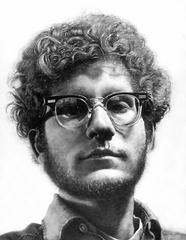Curriculum Materials: Art in America
|
|
Image 27 Chuck Close Questions: |
Frank
Frank exemplifies Close's early style. Based on a professional black-and-white photograph composed by Close, it is more a portrait of that photograph than of his friend Frank. Close believed that a split-second photograph could reveal some truth about a person that could be lost in the lengthy sittings of a traditional portrait painter. He did not emphasize his subject's personalities, however. Close hoped that by choosing relatively anonymous subjects, he could encourage viewers to concentrate on his works more as paintings than as portraits. He also emphasized the works as paintings by using enormous billboard-sized canvases.
Close presented a SYMMETRICAL, closeup view of Frank's head and shoulders against a uniform BACKGROUND. Early in his career, he decided to use this same format for all of his portraits so he would not have to concern himself with decisions about COMPOSITION. In this way he could concentrate instead on the painting itself.
The unflattering view of Frank and the blandness of his expression are characteristic of all of Close's early images. He described every contour and shadow of the photograph of Frank, giving the same attention to every detail-tousled hair, bushy eyebrows, facial pores, tightly closed lips. He wanted to explore the relationship of the various parts of Frank's face. One writer described portraits like Frank as "giant face-scapes,"1 since up close they appear as a large continuous surface of small dots, marks, shapes, tints, and tones rather than an image or personality. Looked at in this way, the image of the city reflected in Frank's glasses is no more important than the button on his shirt collar.
This portrait is also about perception - about how we
see. The tip of Frank's nose and the edges of his hair,
ears, beard, and collar are slightly out of focus, as they
appeared in the photograph. Only that area between the nose
and ears, which includes his glasses and the hairs on his
chin, is in sharp focus.
|
|
1 Martin Friedman in Lisa Lyons and Martin Friedman, Close Portraits (Minneapolis: Walker Art Center, 1980), 13.
